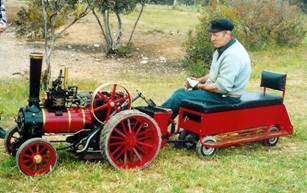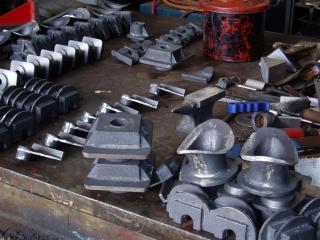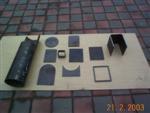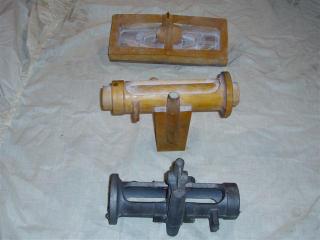Your Workshop
The minimum equipment you will need or need access to, includes:
- A lathe
- A mill (or milling attachment on your lathe)
- A drill press
- A band saw or cutoff saw
- A grinder and/or a linisher
- Electric and gas welding set
- Varous measuring bits and pieces like a vernier caliper, a
micrometer, a steel ruler, etc
Most of the components on the 3" Allchin are less than around 150mm in
size, and so if you make the decision to buy in the machined wheel rims
(front and back), and the compensating centre, then your lathe would
need to be no larger than , say, one with a 150mm centre height and a
mill with a 150mm wide table.
Don't be too concerned if your welding is not fully up to par, a steel
boiler has to be done by a qualified boilermaker anyway.
There is a lot of silver soldering and riveting required on the tender,
so make sure you have access to some gas welding equipment. |
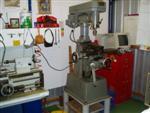 |
Your Contacts
The heart of the Allchin is its boiler. So before doing anything else,
find yourself a boiler inspector. He/she will ensure that your boiler
is designed and constructed according to the boiler code (steel or
copper) compiled by the Australian Miniature Boiler Safety Committee
(AMBSC) using powers delegated to it by relevant Occupational Heath and
Safety Regulations.
Boiler Inspectors are appointed by the model clubs who operate under
the AMBSC code. This would include virtually all the model railway
clubs throughout Australia.
Many clubs cater for road vehicles as well as railways. So find a
conveniently located club that caters for traction engines, and join
it.
Having joined a club, then seek out someone who has actually built a
model. Their help will be invaluable. If necessary, contact our group
|
|
Your First Purchases
Having decided to build the 3" Allchin, you should first buy:
- a set of plans These are available from A J Reeves There are 17 sheets in
the set prepared by the late W.J.Hughes. They are for a model at a
scale of 1 1/2 inches to the foot and using a copper boiler. (You may
also want to buy a copy of the book "Building the Allchin Traction
Engine" by W J Hughes. It has a blow-by-blow description of what to do
and how to do it. (Contact A J
Reeves or Camden ) If
you decide to build a 3" model and use a steel boiler, then you will
need to double every dimension and also make allowances for the
diameter of your steel boiler barrel which might not be exactly twice
that specified by Hughes. The conversion process is very easy if you
are at all familiar with spreadsheets.
If you are having difficulty with this, click
for a list or contact us for the file
or print out of the conversion table.
- A copy of the relevant boiler code. Part 1 for copper boilers
and Part 2 for steel boilers, available from the Australian Association
of Live Steamers (AALS) 16 Protea Avenue, Coromandel Valley SA 5051.
Become familiar with the code and decide if you want to design you own
boiler or obtain a design from us. Either way you will need to have
your boiler inspector approve the plans and have one copy lodged with
your club. If you are computer literate, you may want to consider
installaing a simple computer aided drafting (CAD) program. We use
"Delta Cad"which is cheap and easy to understand. It is available on
line from Delta Cad
- The materials for your boiler. Remember that your boiler
inspector will require you to submit a copy of the compliance
certificate for EVERY piece of your boiler. So make sure you obtain one
when you make you purchase. Cutting the various plates to shape is just
the start. Most will need to have weld preparation done to them and
holes drilled in numerous places. Click here for a comprehensive check list.
|
